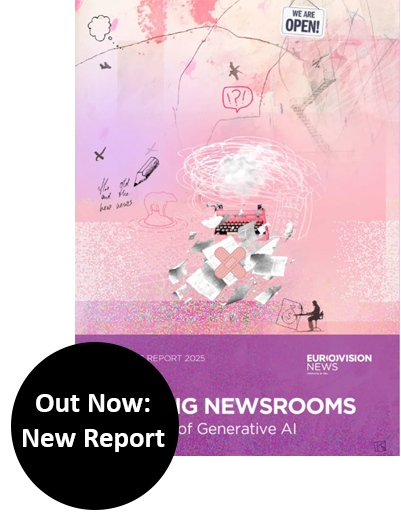In traditional newsrooms, political journalists tend to be those who call the shots. Even in the absence of statistics, it’s safe to bet that the majority of editors-in-chief used to cover politics before rising to the top job. This has shaped pretty much all of journalism. The “he said, she said” variety of news coverage that makes for a large part of political reporting has pervaded other subject areas as well. The attempt to give opposing parties a voice led to the so-called “both-sides journalism” which operates under the assumption that on the marketplace of ideas and opinions those will survive that serve the people best.
But the past few years have already demonstrated that this kind of journalism is not sustainable. First and foremost, it doesn’t serve humanity well in the case of imminent and severe threats like climate change or attacks on democratic institutions where bothsidesism is not an option. Also, newsroom metrics have shown again and again that audiences tend to be put off by news content that just amplifies opinions and intentions of decision makers without linking it to people’s lives. News avoidance is real and has been growing.
“What if reporting on racist, misogynist, dehumanizing opinions and comments has the opposite effect from what most journalists intend — normalizing propaganda and even making political candidates seem interesting?”
The result of the 2024 U.S. election and the rise of authoritarian leaning extremists in other democracies should have served as the final wakeup call for political journalism. What if the media’s calling out those who don’t respect democracy and its institutions doesn’t deter people from voting exactly those politicians into office? What if reporting on racist, misogynist, dehumanizing opinions and comments has the opposite effect from what most journalists intend — normalizing propaganda and even making political candidates seem interesting? And what if newsrooms who complain about political polarization have contributed their fair share to it themselves? Polarization has been a successful business model for journalism after all. These are hard questions that demand answers.
If they want to stay relevant in serving the public, newsrooms will have to double down on studying the impact of their political journalism and think about consequences. Otherwise, they will continue to preach to the converted and fail in their mission to inform people about real threats to their livelihoods. While there is no quick recipe to disrupt and reinvent political journalism, some of the following ingredients might help to develop an strategy and improve the result:
First, studying human behavior. There is plenty of research and evidence out there on how propaganda works, how those in or aspiring to power use the media to amplify it, and how people react to it. If journalists don’t want to be tools in the hands of those ready to abolish press freedom and erode democratic institutions, they better familiarize themselves with these mechanisms. Insights from communication and behavioral psychology should be part of all journalism education and shape newsroom debates. It has become obvious that values and emotions like a sense of justice, pride, shame, and fear shape people’s voting decisions often more than rational choice theory would suggest. Newsrooms must account for that.
Second, chasing data, not just quotes. For political journalists, quotes are data, for other people not so much. They deserve to know what happened, not what someone says they might want to see happening or intends to make happen once in power. Data journalism — increasingly improved by the capabilities of artificial intelligence — provides plenty of opportunities to paint pictures of the real world instead of the world of intentions and declarations. Political journalism can be more interesting when people see how politicians have actually performed in contexts where they were responsible. Needless to say that data journalism needs to be made engaging to appeal to a variety of audiences.
Third, connecting reporting to people’s everyday lives. Politicians have an agenda and journalists are often swayed by it; people are likely to have different ones. Observers might have been baffled that voters didn’t give the Biden administration credit for the strong state of the American economy, but apparently all many people saw before casting their vote was their rising cost of living. Most people care deeply about issues like housing, personal security, the education of their children, health, and care for aging relatives. Only, most of these issues are linked to citizens’ immediate surroundings, their communities. Unsurprisingly, local news tops the list of interests in all age groups when asked for their journalism preferences, as the 2024 Digital News Report revealed. But with diminishing investment in local journalism, many of these topics have been under covered in recent years. A disconnect between political journalism and people’s lives has emerged that needs to be remedied.
Fourth, choosing appropriate formats. Modern newsrooms target different audiences with different formats on the platforms these audiences engage with. Political journalism is still too focused on the audiences that they have traditionally served. It is often made for well-educated groups and decision makers. If newsrooms really want to reach people beyond the community of like-minded news consumers, they need to explore how these audiences can be attracted. There are high hopes in the industry that artificial intelligence can assist in making journalism more appealing and inclusive by transcending formats — converting content to text, video, audio, interactive chat, or even graphic novel by the push of a button. It is too early to tell how this will affect news consumption and audience figures in the real world, but many media leaders expect opportunities for stronger news uptake.
Fifth, learning from other fields of journalism. Political journalists tend to be aware of their importance in the internal hierarchy. Many of them feel proud to do “the real thing” instead of covering entertainment, sports, personal finance, and the like. This might help them to digest the fact that colleagues in other fields score higher in the audience metrics department. But it’s exactly these colleagues political journalists could learn from to improve their own game. They could ask the science desk how to best deal with data and how to break down complex matters in digestible formats. They might get some advice on humanizing stories from those reporting on sports or celebrities. They could learn from investigative reporters how to pace oneself when seemingly sensational material is at hand and how to cooperate with others. And they could practice churning out one or the other service story. In fact, the whole newsroom should be interested in improving political journalism, since at times politics is part of most subject matters.
If journalism wants to maintain its legitimacy, relevance, and impact — particularly in an age when artificial intelligence will make content production ubiquitous — it needs to urgently rethink political journalism. Making it appealing to broader audiences and attracting them to engage with it might be no less than a matter of its survival. Many media leaders are aware of this. Chances are that in 2025 newsrooms will finally rethink the paradigm of political journalism.
This text was published by Harvard University’s Nieman Lab in their Journalism Predictions for 2025 series.




